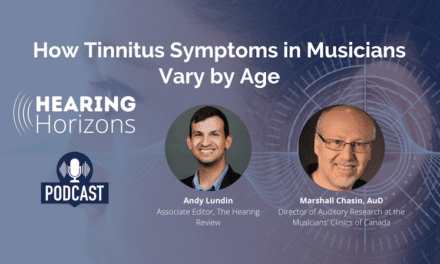It’s a ringing, a buzzing, a hissing, or a clicking—and the patient is the only one who can hear it.
Complicating matters, physicians can rarely pinpoint the source of tinnitus, a chronic ringing of the head or ears that can be as quiet as a whisper or as loud as a jackhammer.
A study conducted by Henry Ford Hospital, Detroit, finds that a noninvasive imaging technique can aid in the diagnosis of tinnitus and may detect a reduction in symptoms after different treatments, offering hope to the more than 50 million patients with tinnitus, says a statement released by the hospital.
Study co-author Michael D. Seidman, MD, FACS, director of the Division of Otologic/Neurotolgic Surgery in the Department of Otolaryngology-Head & Neck Surgery at Henry Ford Hospital, said in the statement that “until now, we had no way of pinpointing the specific location of tinnitus in the brain.” This imaging technique, magnetoencephalography (MEG), can determine the site of perception of tinnitus in the brain, which could in turn allow physicians to target the area with electrical or chemical therapies to lessen symptoms, according to study results presented at the American Academy of Otolaryngology – Head & Neck Surgery Foundation Annual Meeting.
"Since MEG can detect brain activity occurring at each instant in time, we are able to detect brain activity involved in the network or flow of information across the brain over a 10-minute time interval," said co-author Susan M. Bowyer, PhD, bioscientific senior researcher, Department of Neurology at Henry Ford Hospital. "Using MEG, we can actually see the areas in the brain that are generating the patient’s tinnitus, which allows us to target it and treat it."
Imaging techniques currently used to study tinnitus in the brain—PET and fMRI—provide a general location but are not successful at determining the specific site in the brain that is generating tinnitus symptoms, according to the statement.
MEG, by comparison, measures the very small magnetic fields generated by intracellular electrical currents in the neurons of the brain. Some 20 sites in the United States, including Henry Ford, are equipped with a MEG scanner, says the statement. MEG is used at these sites for presurgical brain mapping for patients undergoing surgery for brain tumor removal and epilepsy treatment.
"With PET and fMRI, most of the auditory cortex of the brain lights up with activity during imaging. MEG, however, is a much more sophisticated machine and it can identify a specific tone or topic point, so only a small area in the brain lights up,” said Seidman, director of the Otolaryngology Research Laboratory and co-director of the Tinnitus Center at Henry Ford. “It’s like having the lights on in only the city of Detroit, compared to having the lights on in the entire state of Michigan,"
For the study, Seidman and his colleagues collected MEG results from 17 patients with tinnitus and 10 patients without tinnitus. MEG data were collected for 10 minutes, and then digitally filtered. Study participants wore earplugs to eliminate outside sounds, and kept their eyes open and fixated on one point on the ceiling in the room during testing.
With tinnitus patients who have ringing in one ear (unilateral tinnitus), MEG imaging detected the greatest amount of activity in the auditory cortex on the opposite site of the brain from their perceived tinnitus. For patients with ringing in the head or both ears (bilateral tinnitus), MEG imaging revealed activity in both hemispheres of the brain, with greater activity appearing in the opposite side of the brain of the strongest perception of tinnitus.
Patients without tinnitus had multiple small active areas in the brain, but no particular areas were found to be highly coherent during the 10-minute MEG scan.
Seidman says the study establishes MEG as an effective clinical tool for localizing the probably source of tinnitus in patients’ brains, and it also has the potential to assist with the development of future interventional strategies to alleviate tinnitus.
Reference: Detection of Tinnitus by MEG Using Coherence Imaging, 2009 AAO – HNSF Annual Meeting & OTO Expo. Seidman presented the study on October 3.
[Source: Henry Ford Health System]




